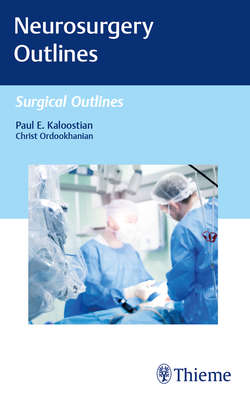Читать книгу Neurosurgery Outlines - Paul E. Kaloostian - Страница 57
На сайте Литреса книга снята с продажи.
Surgical Procedure for Anterior Cervical Spine
Оглавление1. Informed consent signed, preoperative labs normal, no Aspirin/Plavix/Coumadin/NSAIDs/Celebrex/Naprosyn/other anticoagulants and anti-inflammatory drugs for at least 2 weeks
2. Appropriate intubation and sedation and lines (if necessary) as per the anesthetist
3. Patient placed in supine position, breathing through endotracheal tube with ventilator
4. Neuromonitoring may be required to monitor nerves
5. Time out is performed with agreement from everyone in the room for correct patient and correct surgery with consent signed
6. Make a 2 to 4 cm (about 1 inch) transverse neck crease incision at the appropriate level off of the midline
7. Incise fascia over the platysma muscle and split it into a superficial plane in line with the neck incision
8. Identify anterior border of sternocleidomastoid muscle and incise fascia to retract it laterally
9. Identify and retract strap muscles medially (sternohyoid and sternothyroid), forming another middle plane
a. The plane between the sternocleidomastoid muscle and the strap muscles can now be entered
b. A plane between the esophagus and the carotid sheath will be created next for entry
10. Identify the carotid pulse and retract carotid sheath laterally
11. Cut through the pretracheal fascia
12. Localize superior and inferior thyroid arteries, tying them off if necessary
13. Split longus colli muscles and anterior longitudinal ligament
14. Subperiosteally dissect to identify anterior vertebral body, utilizing retractors and an operating microscope
15. Retract longus colli muscles laterally, forming a deep plane
16. Dissect thin layer of fibrous tissue covering vertebra away from disk space
17. Once the bone is exposed, it is best to localize and verify the correct vertebra via X-ray or fluoroscopic imaging and confirming with at least two people in the room
18. Perform the diskectomy over segments needed based on preoperative imaging of levels that are compressed due to tumor:
a. Using Leksell rongeurs and hand-held high-speed drill, remove the appropriate disk(s) or perform a complete corpectomy for added exposure
b. Identify location of tumor and resect tumor as needed if epidural or within the spinal canal/cord (with care not to injure the vertebral artery)
i. Use operative microscope and open the spinal cord dura midline with 11 blade and tack up the dural leaflets with suture (see ▶Fig. 1.24)
ii. If tumor is intradural and extramedullary, the tumor can then be resected carefully with microdissection technique without cord injury (neuromonitoring needed in these cases)
iii. If tumor is intradural and intramedullary, with microdissection technique the cord must be entered midline and the tumor must be identified and resected starting centrally first, then around the edges (neuromonitoring needed in these cases)
19. After appropriate tumor resection, there may be need for additional stabilization to prevent kyphosis if the resection caused multiple segment decompression. Therefore, instrumentation with anterior cage and plate can be performed.
20. After appropriate hemostasis is obtained, muscle and skin incisions can then be closed in appropriate fashion, often with placement of postoperative drains that can be removed after 2 to 3 days
